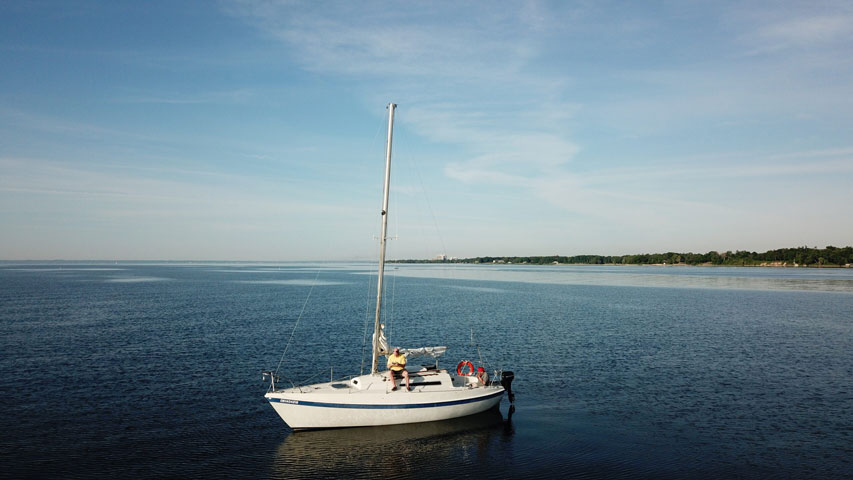Reefing is meant to increase your ease-of-use, flatten sail shape, reduce sail area, and re-position the boat’s center of effort. This reduces heeling and de-powers your sails to improve safety and stability in rough weather.
Reefing is an important part of sailing to learn and understand how to do efficiently and effectively. This guide is meant to give a general overview of the process and discuss the preparation a sailor should take. There are various methods of reefing and each sailor has their own process. Nonetheless, whether you are slab reefing, in-boom reefing, in-mast reefing your mainsail, or furling in your headsail the principles remain the same.
Preparation is essential
Being prepared for heavier winds and identifying when to reef is key to maximizing the performance and safety of the boat. Here are several things every sailor can do to be prepared:
Keep lines organized
Make sure to have your lines organized beforehand and a reefing plan in place. This will assure that each time a crew member reefs the same actions are taken to re-organize the lines so no time is lost figuring out what the preceding person has done.
Practice Makes Perfect
Taking time to exercise your reefing routine will ensure that your crew is ready when that gale approaches. Additionally, having a plan in place will keep your crew focused during turbulent weather by overcoming their hesitation with confidence to handle the situation swiftly and correctly.
Check the Forecast
With the multitude of devices and apps which show weather patterns, wind speeds, and forecast predictions available today no sailor should be fully unprepared for the weather they are going to face.
Reef Before You Need To
When it comes to knowing when to reef, not every sailor, boat, sail or breeze is equal.
“It depends on the boat, and the sailor,” says one of our designers, Jeremy Roszmann, “more cautious sailors will reef earlier, and some boats will heel more in different winds”. A boat’s design, sail inventory, and crew experience are all factors in determining when reefing should take place.
“It’s pretty difficult to give an ‘at 15 knots take your mainsail to reef 1’… headsails sort of follow the same line. You can theoretically run your 150 Genoa up to 20 knots, and I’ve had clients ask for extra reinforcements because they do, but you risk causing undue stress on the cloth, running into shape issues quicker and in-time sail failures”.
One common saying about reefing is that if you think you need to reef, you should have already reefed. “I avoid telling clients when to reef because if they feel they should reef, they should. Until either, they are more experienced sailors or they are more comfortable sailors”. Every boat is going to handle wind speeds differently due to their design and sail inventory. It is important to practice reefing so that you can be fully prepared and know when to reef before you need to.
How to Reef
While there are many methods to reefing the core concept is the same: to efficiently reduce sail area in order to stabilize the boat in varying winds. Sailing Uma has made a wonderful video on how they go about reefing their mainsail, watch the video below and visit Sailing Uma’s partner page, and website to show some support.
Reefing your mainsail
- Ease the main-sheet. This will cause the mainsail to luff, stabilizing the boat by reducing heel and easing the tension on the mainsail making it easier to drop.
- Reduce Tension on the boom vang. This will allow the boom to move up or down dependent on where the reefing points are located on the mainsail.
- Lower the main halyard, and hook the reefing point onto a carabiner or ram’s horn to set the new tack position of the sail. Tie sail ties around the boom through the grommets if necessary to contain the loose material left over. If you use a stack-pack the loose material will be gathered inside the folds.
- Similarly, make sure that your reef clew has been secured properly in place.
- Haul in the first reef line.
- Tension the main halyard. Don’t be afraid to crank it tight, your sail is reinforced at it’s Cunningham.
- Tighten up the boom vang in its new position.
- Trim the main-sheet.
- Bonus Uma Tip: Stow your main halyard and lines, in the same way, each time. Then no time is wasted figuring out what the previous person had done.
Shaking Out a Reef
Follow the above steps in reverse order, making sure to re-tension and trim for the new position of the sail.
Don’t Forget Your Headsail
Adjusting your Genoa or Jib can help balance out the boat and reduce heeling. Furling in your headsail is a great way to reduce sail area.
Simply furl in your headsail as you normally would but stop prematurely to determine the size reduction you want to make.
For areas with seasonal variance in wind strength or for those sailors traveling to areas with different conditions, if you find yourself constantly furling your 150% down to 115% that you might want to consider increase your sail inventory. When you constantly are partially furling your headsail you are doing two things:
- Furling away sail shape which causes a decrease in performance compared to a sail meant for the conditions.
- Increasing the pressure applied to the unfurled portion of the sail while the other portion remains untouched from the stretching causing your sail to become “baggy” over time.
How Many Reefs Should a Mainsail Have?
Again, this will be different based on the sail inventory, experience, boat, and sailing conditions for each person. Ron, our Lead Sail Consultant regularly recommends that “one reef keeps you sailing, two gets you home safely”.
Can Reefing Damage Your Sails?
The size of the sail, cloth weave, weight, and design will all play large factors in determining how fast a sail will stretch. As Jeremy said earlier, “you can theoretically run [a] 150 Genoa up to 20 knots… but you risk causing undue stress on the cloth, running into shape issues quicker, and in-time sail failure.”
Think of it this way, if you have a 150 Genoa and you are furling it to a smaller size constantly due to the wind conditions where you sail you are not only furling away sail shape (making it less efficient) but you are also using the sail outside of its intended conditions. Having a few sails in your inventory, like a 115, 150, and a Trysail is a great option as it allows you to reduce sail area more efficiently depending on the conditions.
“Reefing sails to induce the qualities of another sail, i.e. reefing to third reef instead of a Trysail on-board, can damage specific areas of the sail, damaging the smooth vertical representation that we design in the sail. In the example above you would slightly bag out the top of the sail which means that you have a deeper top which encounters higher velocities, and could cause weather helm in the boat.”
Likewise, if you are constantly reefing your mainsail to the first or the second reef the exposed area is being stretched at a greater rate than the hidden section. This can cause the sails to become baggy and impairs the efficiency of the design of the sail.
This isn’t to say you shouldn’t reef. Well built sails will be able to handle the strain that comes from sustaining a reef and there are many ways to reinforce your sails to prolong their lifespan.
Panel Layout and Sailcloth Weight Are Important
Higher quality Dacron sailcloth has increased resistance to stretch and UV damage to prolong their shape-holding life. Meaning you can sail more aggressively without being concerned about stretching too early. Tri-Radial Dacron sails have greater resistance to stretch due to their design and the load-bearing properties of the seam layout. Laminate sails are the complete solution to stretching, but unfortunately, lack the resistance to UV that is needed for longevity. You can learn more about sailcloth and crosscut vs tri-radial designs in our blog.
Cloth Weight
For a long time it was thought that the heavier the sailcloth, the better the sail. We still get asked this question everyday but heavier cloth does not mean that it will last longer. Here is what our designer Jeremy had to say about it: “Cloth weight is determined on the size of the boat, usually in LOA (ft/m). Larger boats induce more displacement and require a larger sail which will have to undertake more force to move the boat. Too light of cloth, while providing superior performance, risks tearing or warping very quickly. ”
Design is Crucial for New Sails
The design of your sail is a crucial step in preparing your it to perform well in heavier winds. Precision Sails prides ourselves on our leading design consultations to build the best sail possible for your boat. Our designers get to know you, your boat, the conditions your sailing in, long term plans, and experience level to select the best cloth, weight, and features for your sail. Here are some of the features your new sail can have:
Foam Luff
“A foam luff allows you to furl in the sail partially and maintain lift in the front camber of the sail, this allows someone with a 150 Genoa to furl it into a 140 and sail in higher winds.” Think of a sail like an airplane wing, it has a specific curved surface. When you furl you are changing the draft of the sail, the curve, which causes it to be less efficient.
Navigator package
Designed for the blue water sailor, the Navigator Package represents the pinnacle of superior quality and custom design. This package includes:
- Double Tapes along the Leech, Luff, and Foot of the sail.
- Triple Row of Triple Zig Zag Stitching.
- Tie-in, Velcro, or Flip-Flop Batten Pockets
- Dyneema Leech and Foot Lines with Covered Cleat.
- Premium UV Treated Thread:
- Tenera, Serabond, Serafil, Lifetime
You can learn more about our Navigator Package here.
Mariner Package
Our Mariner Package is defined by its customizable options and hands-on approach to sail design. This premium package allows sailors to upgrade everything from their hardware to points of attachment of the sail, while working one-on-one with their sail designer
Learn more about our Mariner Package by submitting a quote request.
Helmsman Package
Our Helmsman Package is designed to check off the fundamentals on every sailors list. This package offers the perfect collaboration of choice from trimming tools to finishing options, allowing sailors to design their ideal sail knowing Precision Sails craftsmanship ensures perfection every step of the way.
Learn more about our Helmsman Package by submitting a quote request.
Block and Radial patching:
These corners have been designed to better distribute the load. Our unique radial corner design is stronger and more durable than the competition and prevents premature material failure.
And Many More
Precision Sails prides ourselves on building custom sails for your boat and sailing conditions. Our sails are fully customizable and we have many other sail enhancements and customization options for you to consider.
Thinking about getting new sails?
Start the conversation by scheduling an appointment with one of our sail consultants.







